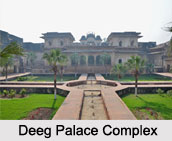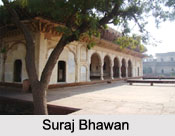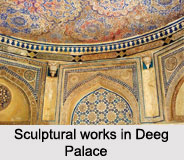 Monuments of Deeg comprised of the historical Deeg Palace, Deeg Fort, Suraj Bhawan, Hardev Bhawan, Kishan Bhawan, Kesav Bhawan, Nand Bhawan and Gopal Bhawan. All these architectures are the tourism attractions. The monuments of this town also comprised of architectural influence of Persia. These palaces in Deeg comprised of Persian charbagh as it was the earlier retreat of the Princes of Bharatpur when Deeg was included with the Princely State of Bharatpur during the rule of British Empire in India.
Monuments of Deeg comprised of the historical Deeg Palace, Deeg Fort, Suraj Bhawan, Hardev Bhawan, Kishan Bhawan, Kesav Bhawan, Nand Bhawan and Gopal Bhawan. All these architectures are the tourism attractions. The monuments of this town also comprised of architectural influence of Persia. These palaces in Deeg comprised of Persian charbagh as it was the earlier retreat of the Princes of Bharatpur when Deeg was included with the Princely State of Bharatpur during the rule of British Empire in India.
Deeg is historically related as the platform of the Jat tribal rulers in 18th Century. Some of the monuments were mainly constructed during the reign of Jat rulers like Badan Singh and his son Suraj Mal. The structural design incorporated in the building of the palaces and forts were influenced from the architecture of the Mughal Dynasty.
Deeg Palace
Deeg Palace is a palace, was once the summer resort for the kings of Princely State of Bharatpur. It was built in 1772 AD. Deeg Palace consists of many havelis and the well laid gardens of Mughal styles of architecture.
 Purana Mahal
Purana Mahal
Deeg became a capital city under the dominion of Badan Singh. He constructed the Purana Mahal which draws influence from the Rajput style of architecture. Most of the buildings in Deeg were constructed by Badan Singh`s able son Suraj Mal, the ruler of Bharatpur.
Deeg Fort
Deeg Fort is a prominent fort in Deeg. The entire fort is surrounded by a shallow wide moat and the gateway to the fort is confined with anti-elephant strikes. The huge towers are the most impressive part of Deeg fort, the largest of which is the Lakha Burj.
Deeg Bhawan
Deeg Bhawan is popularly known as Jal Mahal. This palatial house was built by Suraj Mal and Jawahar Singh. This house was constructed with sand stone of pinkish color from Bansi Paharpur.
Suraj Bhawan
Suraj Bhawan is named after Suraj Mal. This is a single storied building inside Deeg Palace which has very close resemblance with Taj Mahal and Agra Fort. It was the place for relaxation by the queens of Bharatpur.
 Hardev Bhawan
Hardev Bhawan
Hardev Bhawan was built by Suraj Mal. It has a central hall, faced with arches springing from a row of double pillars.
Kishan Bhawan
Kishan Bhawan served as communicating house with the peasants and the kings. The architecture of this house is similar with Gopal Bhawan. Kishan Bhawan is like a foliaged hut-like curved roof with delicate decorative details. At the back side of Kishan Bhawan, there is a long corridor with a raised floor leading to a small cell and a room on either side. The pavilion surmounting Kishan Bhawan in the southern part was erected by Balwant Singh.
Kesav Bhawan
Kesav Bhawan is a single storied palace. It is commonly known as Baradari. It is semi-octagonal in shape which is similar with the minars or towers of Mughal monuments in Delhi.
Nand Bhawan
Nand Bhawan is an auditorium used for cultural meets by the rulers of Bharatpur. It is a grand arcade with seven gates. The ceiling of this room is an imitation from Diwan-i-khas.
Gopal Bhawan
Gopal Bhawan was built by Suraj Mal near the lake. It is based on a flat roof with three principal portions. The royal reception hall is similar with Diwan-i-Am. The eastern facade of this palace is built with the majestic arches and sculptured imposing pillars. This palace has two royal houses named "Sawan" and "Bhadon". Most of the marbles were taken from the palace of Jawhar Singh.



















